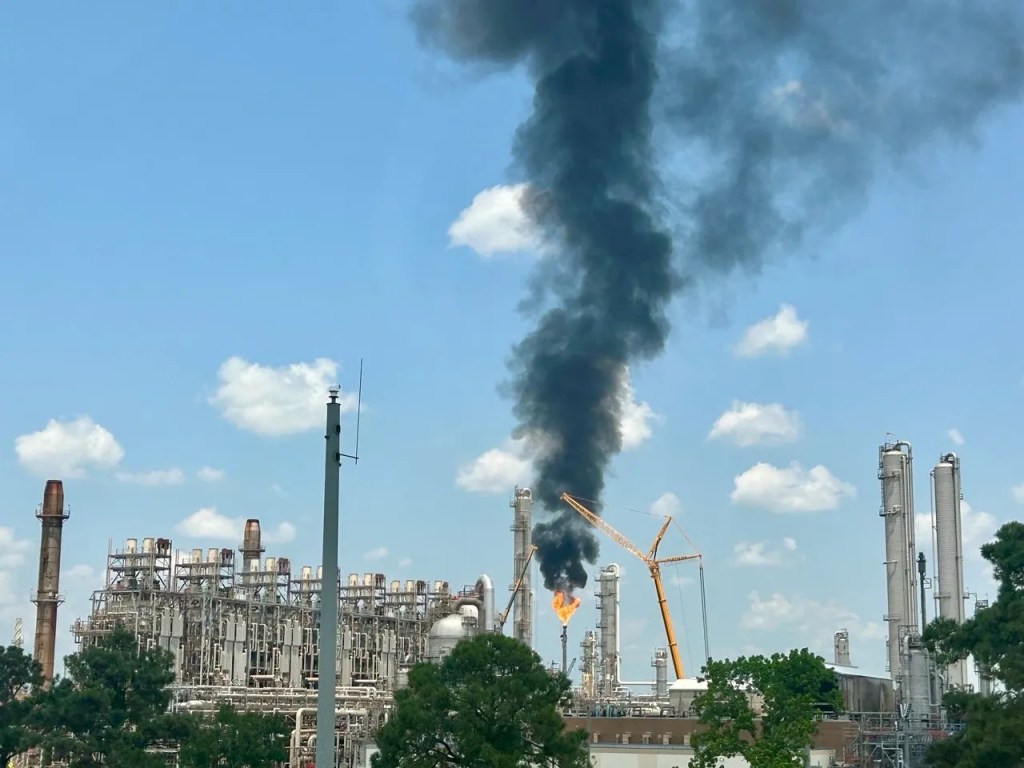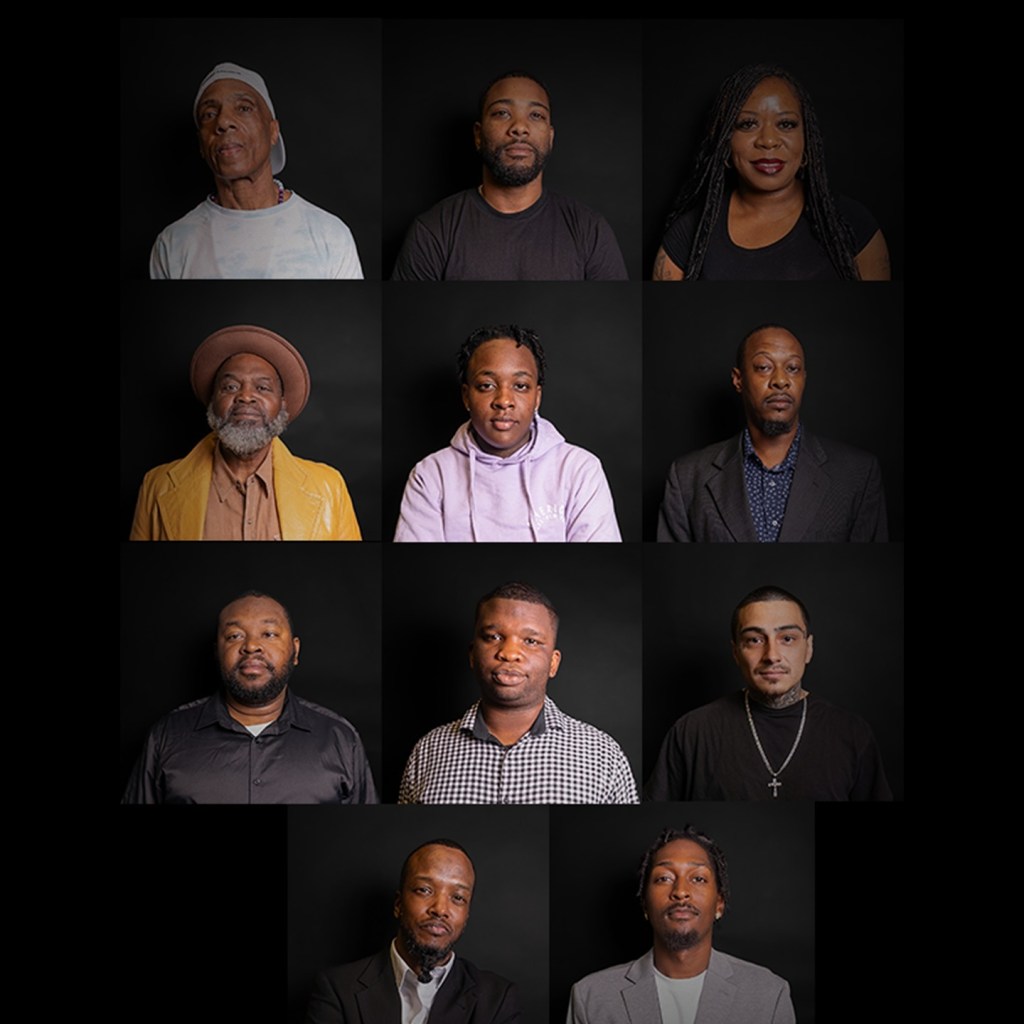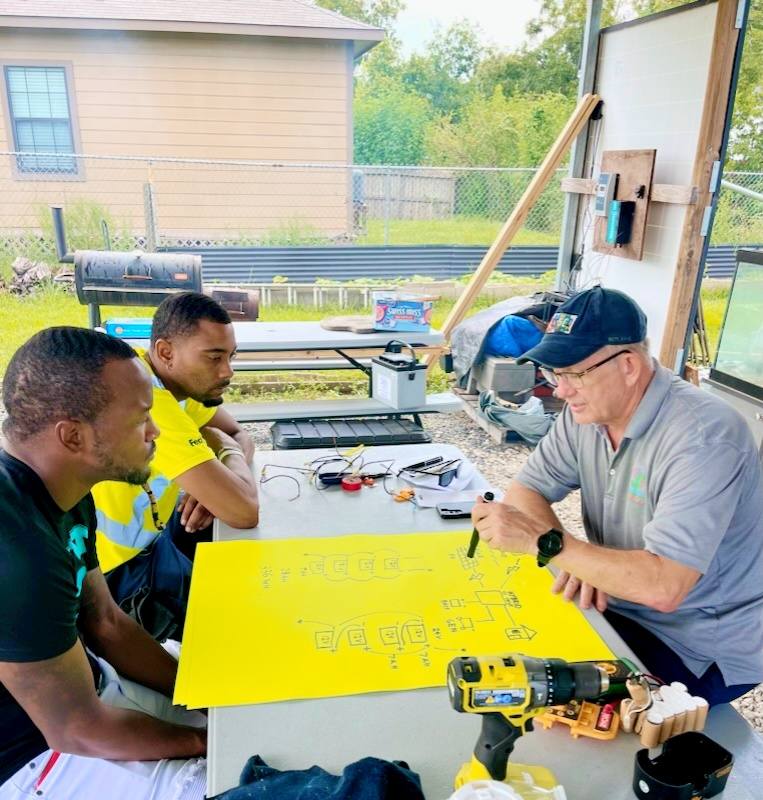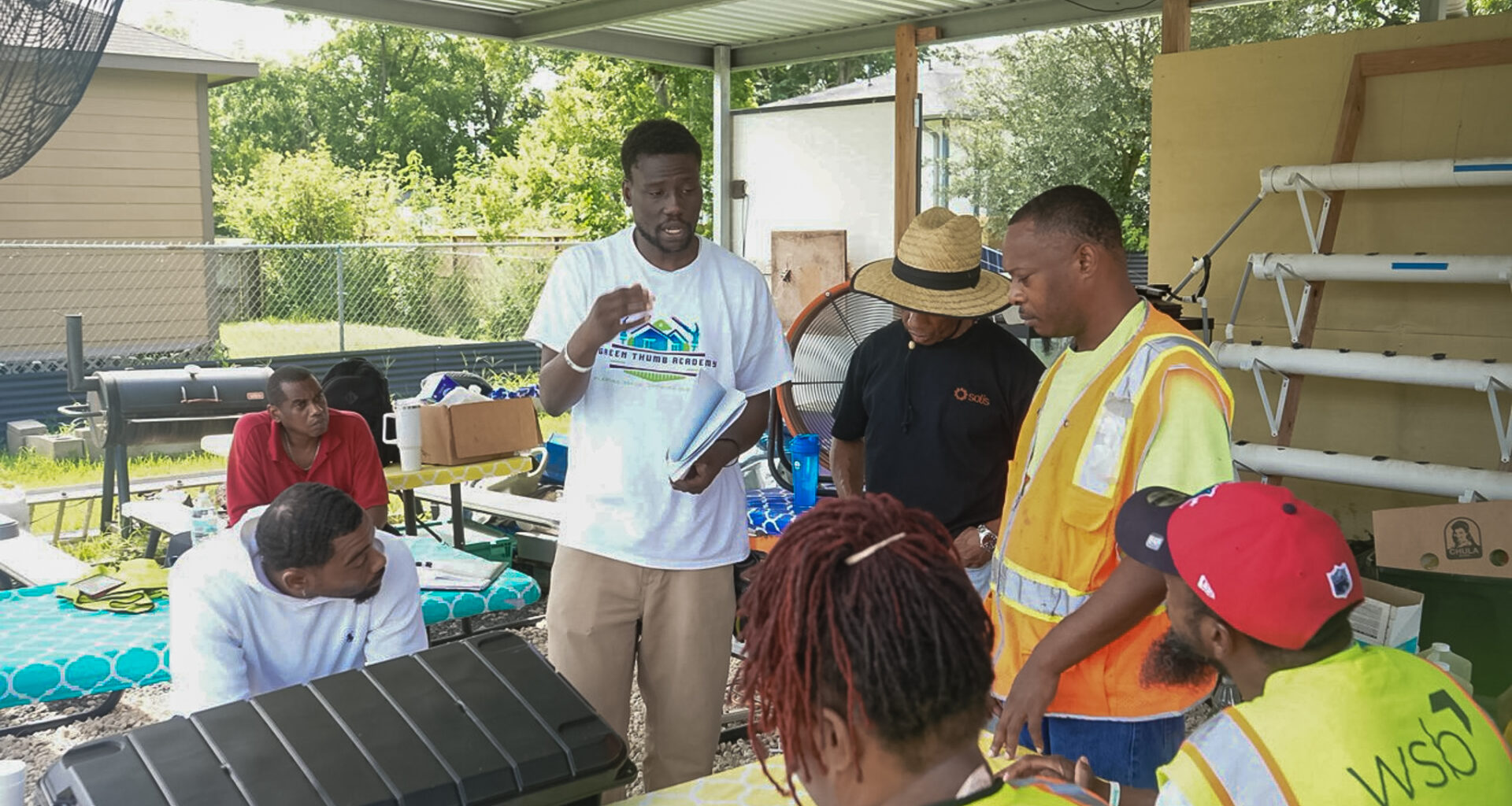HOUSTON — Leon Dillard gripped the solar panel tight, sweat stinging his eyes as he scaled the sun-baked roof for the first time. His adrenaline racing, he remembered making sure his harness was clipped not once, but twice.
He’d never climbed up onto a roof before, let alone with a 50-pound panel of metal and wires strapped to his body. Each step tested his nerves. He could feel the shingles shift beneath his boots, and the June heat pressing through the soles. Below, life in Houston’s Fifth Ward unfolded: a swirl of distant freeway noise, laughter from his co-workers, and the ever-present backdrop of refinery stacks on the horizon.
Less than a year earlier, locked behind prison walls, he never could have imagined being handed the chance to invest in his city — or, even more improbably, to be investing in himself. Yet here he was, working shoulder-to-shoulder with a team to transform sunlight into electricity, forging a new sense of purpose in every bolt and connection.
This past summer, Dillard was one of roughly 50 participants in an inaugural solar installation training program geared toward Black, low-income residents of Houston, many of them formerly incarcerated, and from parts of the city long associated with poverty and pollution.
The 22-week training hosted by the Black United Fund of Texas, the city of Houston, and the Green Thumb Academy offered students not just a steady paycheck of $18 an hour and certification in solar installation via the National Center for Construction Education and Research, but the possibility to heal, build, and protect their communities.
“It gave me a sense of purpose,” said Dillard, a 37-year-old who was incarcerated for two years before his release in September 2024.
As he puts it, his hometown is the “energy capital of the world.” But for so long, that designation has actually come at the expense of the Black people who call Houston and Southeast Texas home, researchers have concluded. For generations, Fifth Ward residents unknowingly lived on a plume of coal tar, toxic waste from a neighboring rail yard that was abandoned and leached into the soil. Eventually, cancer clusters began to develop in the neighborhood. Today, residents are expected to die two decades before residents born in more affluent and white Houston neighborhoods.
But Dillard said this program was allowing him to do work that breaks cycles of harm while literally generating cleaner futures for the neighborhoods that have long been burdened by oil and gas pollution.
“Being a part of [the program] felt like creating history,” he said. “Learning the trade with people from similar backgrounds [not only] gave us something to offer back to society, but also ourselves.”
Yet the very training that provided Dillard a lifeline almost disappeared as quickly as it began.
The program was funded in part by a $20 million grant from the federal Environmental Protection Agency to the Black United Fund of Texas and the Houston Health Department. It was a part of President Joe Biden’s Inflation Reduction Act, a $2 billion pool of money meant to stimulate the economy by investing in infrastructure upgrades to protect communities from climate threats like hurricanes and wildfires. The Biden administration also wanted those funds to be used to address environmental justice issues, which residents of Fifth Ward said they have faced in the form of pollution for decades.
However, the funds were targeted for reversal in Project 2025, the conservative manifesto that the administration of President Donald Trump uses as a framework for many of its policies. In May, Trump directed the EPA to cancel the grants, leaving the Houston training program in limbo. Later in the summer, the administration sought to cancel $7 billion in funding for solar programs and installation in Black and low-income areas. About a quarter of the students dropped out of the Houston program after the funding issues were made public.
Still, that didn’t stop the Black United Fund.
“We’ve worked before without literal dollars,” Velika Thomas said in February as Trump began his environmental cuts. “It would be awesome to have the money, but we’re going to get through it somehow” without federal support. And even with an annual budget of around $250,000, the organization did just that. The program combined funds and grants to pay the wages of the trainees.
For Thomas, the dilemma confirmed how important it is to support her own community. “As a Black person, I have not felt that America has ever put us at the forefront,” she said. “We are not a waste; the community is not a waste.”
As the Trump administration continues slashing federal support for climate programs and dismissing the impact of environmental racism, leaders of the program known as Vulnerable to Vibrant say cities need to continue to put forth such solutions even without federal support.
Advocates said community support in the form of donations can also sustain critical climate programs even if the federal government reduces or stops direct funding. Last year, environmental organizations saw an 8% increase in giving, reaching an all-time high of nearly $22 billion being donated for such work. Between 2021 and 2023, the donations and grants received by the Black United Fund nearly quadrupled.
 After prison, Leon Dillard went through a city-led reentry program, where he first found out about the solar installation opportunity. On his table are laminated copies of his new diplomas and certificates. (Adam Mahoney/Capital B)
After prison, Leon Dillard went through a city-led reentry program, where he first found out about the solar installation opportunity. On his table are laminated copies of his new diplomas and certificates. (Adam Mahoney/Capital B)
“We can chart a way out while doing good for our people,” Shanitra Sanford, a graduate of the solar program, told Capital B. “We should all strive for that.”
Despite the disruption in federal funding, state and philanthropic investments continue to produce measurable local outcomes. Programs have popped up in each of the 10 geographic regions of the U.S. organized by the EPA. Watts Rising in Los Angeles has completed dozens of rooftop solar installations and multiple job placements in energy workforce pipelines for low-income residents. Chicago’s Renewing Sovereignty Project has certified dozens of formerly incarcerated people for clean energy employment.
For Sanford, who was incarcerated a total of four years, the focus on training people in solar installation is also about investing in a more stable and hopeful future for her three children, whose ages range from 2 to 15.
“I want to give them a sense of confidence in themselves and their home,” she said.
 A oil refinery in Baytown, a suburb of Houston, is one of the world’s largest polluters. (Adam Mahoney/Capital B)
A oil refinery in Baytown, a suburb of Houston, is one of the world’s largest polluters. (Adam Mahoney/Capital B)
Health researchers estimate that transitioning the U.S. fully from fossil fuels to clean energy sources like solar could prevent more than 50,000 premature deaths every year by eliminating air pollution from energy-related activities.
Texas now ranks second only to California in total solar energy usage, and employs the third most people in the U.S. solar industry. The state added thousands of new solar jobs last year alone, while oil and gas employment shrank by about 8% since July 2024.
Another community solar group, Green Careers Texas, has connected dozens of trainees from local initiatives across the state and helped complete hundreds of installations through municipal and nonprofit partnerships.
This momentum in clean energy, program managers hope, shows how local action can drive broad impact.
As is the Black United Fund’s motto: “When we help ourselves, we help the total community at large become productive, and being partners in the community ensures the future of all people.”
Texas program connects formerly incarcerated workers to green energy
 Roughly a dozen participants graduated from the solar installation program. (Courtesy of the Black Untied Fund)
Roughly a dozen participants graduated from the solar installation program. (Courtesy of the Black Untied Fund)
Sanford’s introduction to the program was as much about learning the physical realities of solar installation as it was absorbing the layered reasons the training existed in the first place. On most days, participants split time between classroom instruction — covering electrical basics, Occupational Safety and Health Administration safety rights, and the mechanics of solar arrays — and afternoons hoisting panels, climbing rungs, and practicing real rooftop installations on homes and in neighborhood mock-ups.
In a converted classroom in the Fifth Ward, the cohort of men and women — most recently released from Texas prisons — learned together about the ways that this labor could improve the health of their neighborhoods.
Timesha Beattie of Green Thumb Academy, leading a team of trainers and organizers, opened sessions with reminders of what certification could mean for families and neighborhoods: “Once you earn these credentials, nobody can ever take them away. You are going to be able to take back to your families the knowledge, the information, the credentials.” Sanford and Dillard could almost recite back word for word what Beattie said weeks after the class had ended.
The practical details mattered. The city and its partners provided not only a paycheck but the kind of support usually reserved for full-time jobs like direct deposit and worksite insurance. “It was book knowledge, but also it was hands-on — getting that panel on the roof, working as a team, finding out who you could rely on,” Sanford said.
The pay “was pretty good,” Dillard said, but more importantly, it gave him somewhere to be in community in the early months of his release.
 After the 22 week course, not only did participants learn tangible skills, but the scientific knowledge behind solar power. (Courtesy of the Black United Fund)
After the 22 week course, not only did participants learn tangible skills, but the scientific knowledge behind solar power. (Courtesy of the Black United Fund)
Students handled gear, tested wiring alongside mentors, and learned how the electricity generated from sunlight powered nearby homes. By the end of the five-month program, participants could identify wiring color codes, install ceiling fans, and debate the future of Texas clean energy. The path from enrollment to graduation winnowed the group from 50 to a dozen, which training organizers said was a testament to the program’s rigor. But those who remained left with certifications, a pathway to union apprenticeships, and a sense of possibility.
“Learning this trade, whether plumbing, electrical, or construction … it’s something you can do as a career and retire from,” Dillard said.
Rather than training people to leave their community for jobs elsewhere, the program’s structure funneled graduates toward local employment. Training organizers and graduates said they see the initiative as a template resilient enough to function even at a moment when the validity of climate change is under question: rooted in local networks, able to partner with colleges and city agencies, and nimble enough to weather uncertain federal funding. “We have the tools and the networks in our communities to do this,” Sanford said.
Without stable, large-scale federal funding, programs like the one in Houston can make only a small dent in the overall shift to clean energy. Local training and job placements are important, but big challenges — like complex utility regulations and the high upfront cost of solar panels — get in the way. Experts say that to bring clean energy to many more communities, the government needs to restore and expand public investment and create better policies that help these local efforts grow beyond just small pilot projects.
However, replicating Houston’s model is a start. These programs may not guarantee clean energy for every city block, but participants said they offer one blueprint for economic reintegration in neighborhoods overlooked by America’s billion-dollar energy boom.
For the first few months after he was released from prison, Dillard said he would tell anybody he could that being incarcerated was “probably the best thing that ever happened” to him. It was the first time he was able to participate in an educational program that he believed could benefit his life and where he was supported as an individual.
But as the one-year anniversary of his release approached, he said his earlier belief had changed.
“I really just needed to be a part of [the program], be a part of something,” he said as he thumbed at copies of his new certificates and diploma from the training, which he proudly laminated on his own.
“You have to make a choice to take a chance, or your life will never change. But you need other people with you on that journey.”
 Some of the graduates, including Leon Dillard (far left) and Shanitra Sanford (middle) on graduation day. (Courtesy of the Black United Fund)
Some of the graduates, including Leon Dillard (far left) and Shanitra Sanford (middle) on graduation day. (Courtesy of the Black United Fund)

